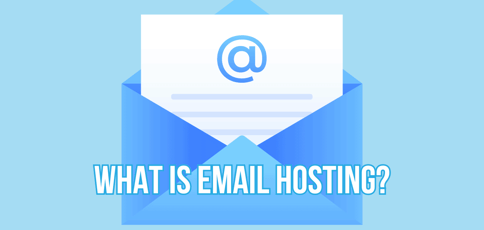
Email hosting allows individuals and businesses to rent out a portion of a server (from a hosting provider) for email. This type of service focuses only on storing, sending, and receiving emails, whereas web hosting caters to websites. Besides those standard capabilities, email hosting services may also provide features like custom domain names, spam filtering, virus protection tools, and mobile email access.
Email hosting plays a crucial role in the operations of any business, considering it ensures that communications get transmitted quickly and securely while also giving businesses a more organized email dashboard.
Businesses also opt for email hosting to improve branding and professionalism. And that’s all thanks to custom domain names for email addresses. As for personal users, email hosting has several benefits: increased storage space, stronger security, custom email addresses, and improved organization with a streamlined email dashboard.
-
Navigate This Article:
Understanding Email Hosting
Knowing how email hosting differs from free email services is essential to understanding it. Options like Gmail and Yahoo provide excellent personal email tools but lack many features that individuals and businesses get from premium email hosting services.
Email hosting usually has a price tag; in exchange, you receive features unavailable from free services, like custom domains, more storage, enhanced security, and email address creation for multiple people. Beyond that, premium email hosting services have many more features and benefits.
Key Features and Benefits
Above all else, these are the features that make email hosting stand out when compared to free email services:
- Custom domain and professional branding: Email hosting allows you to customize the domain name attached to your email addresses, making them unique. Companies like this for branding, professionalism, and legitimacy. It also lets them create several email addresses for workers, all using the same domain name. For individuals, these benefits allow for personal creativity and uniqueness. It’s also great when running one-person businesses (photography, Etsy selling, freelancing).
- Enhanced security and privacy controls: From spam protection to secure password policies, email hosting plans increase the often boilerplate security you receive from free email services. You get secure IMAP and POP connections, privacy controls, regular email backups, and SSL/TLS encryption. Also, expect options for virus protection, data loss prevention, and secure file transfers.
- Collaboration and productivity tools: Many premium email hosting plans include productivity suites with calendars, contact organizers, notes, and file storage. You may even receive online word processors, spreadsheet tools, and website builders. Collaboration features connect the email addresses on your account, often allowing for quick chats between employees, real-time editing of documents, email rerouting, and in-house file sharing.
These features and benefits are the foundation of any reputable email hosting service. In the next section, you’ll learn about the types of email hosting solutions and how to choose the right one for your business or personal use.
Types of Email Hosting Solutions
Most email hosting services include the features outlined in the previous section. Still, there are some additional choices you should make to receive the appropriate amount of resources and features for your use case. To help you decide which solution is right for you, here are comparisons of common email hosting configurations:
Shared Hosting vs. Dedicated Hosting
Shared email hosting is where multiple customers use the same server to host email addresses and messages. Thousands of email accounts could be hosted on a single server, all from different parties. The hosting provider manages the server.
Shared email hosting — the most affordable type of email hosting — works well for small to mid-sized businesses and personal use.
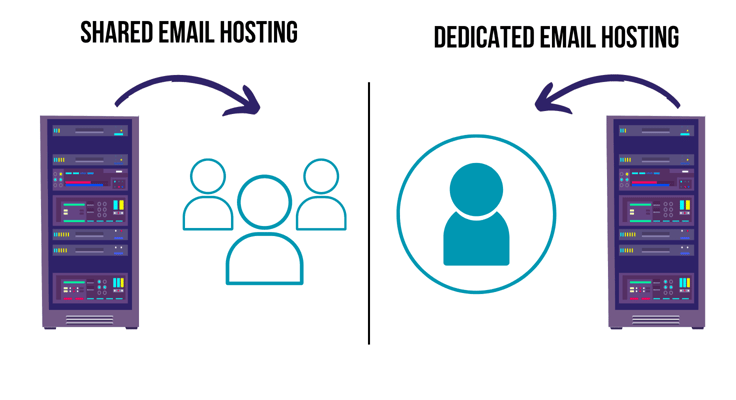
On the opposite end of the spectrum, a dedicated hosting account commits an entire server to one organization. This is one of the most expensive forms of email hosting.
Larger businesses opt for dedicated hosting for its improved speed, server resources, customization, and security. The hosting company still manages many elements of the server, but the user gains control of elements like its operating system.
On-premises vs. Cloud-based Hosting
The next two types of email hosting are good choices for organizations interested in scaling up or improving upon a dedicated email hosting plan. Sometimes, this is the next logical choice from a virtual private server or shared hosting.
An on-premises email hosting configuration is where a business creates the infrastructure for email hosting at the organization itself. This setup provides full control and maximum security, but it requires significant expenses and a dedicated IT department.
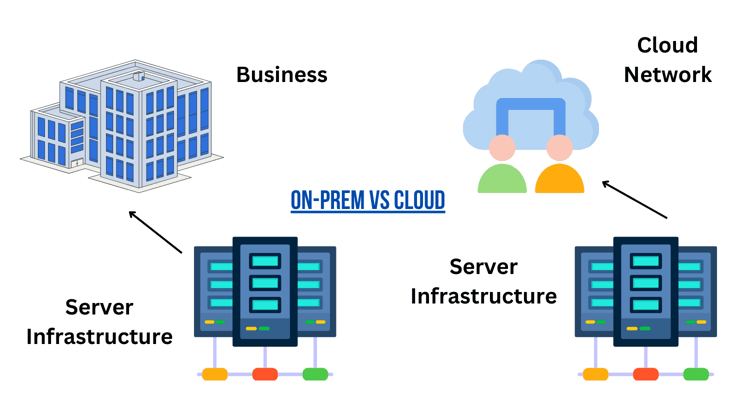
Cloud-based email hosting is becoming popular because of its low risk, affordability, and minimization of on-site equipment. A cloud-based email host — like Google Workspace, Fastmail, or Rackspace — sells premium email hosting services where the user’s email infrastructure is on the cloud.
This provides a remote experience; the host manages servers in a data center, but the customer never touches the server. Users also receive the benefits of a branded email account and browser-based inbox. Cloud-based email hosting comes in handy for businesses of all sizes. Even enterprise-level brands have shifted email hosting to the cloud.
Advantages of Email Hosting
Email hosting offers an array of advantages, from professional branding to security and collaboration. It’s definitely a step up from free email services.
Professionalism and Branding
Nothing says unprofessional like a business using a gmail.com or yahoo.com email address. To add credibility to your communications, it’s wise to make it a custom domain name. For businesses, that’s often the same domain name as their company website. This increases the instances of customers and clients seeing the brand name and, therefore, improves the business’s memorability.
Security and Privacy
Premium email hosting comes with a myriad of security and privacy measures, making it ideal for businesses and privacy-oriented consumers. It all starts with increasing the general security measures you might find from a free email service. You often get protection from phishing attacks, spam, and malware.
As for privacy, many email hosting companies like Fastmail and Proton Mail put privacy before anything else. You can also find ramped-up privacy measures when free cloud-based services sell premium versions of their email services. Look for encryption to protect your communications as they come and go from your inbox. Email hosting providers have a significant privacy advantage over free services with intrusion detection systems, secure IMAP/POP, and data privacy policies. You may also get user permission controls to manage which users can access company email accounts.
Collaboration and Productivity
A major benefit of a paid email hosting package is its potential for collaboration. While this isn’t guaranteed with email hosting, collaboration and productivity tools are becoming more common. For instance, many email hosts like Fastmail and Zoho Mail offer shared calendars, tasks, and contacts for multiple people to see and manage within an organization.
Hosted email providers also tend to offer built-in business and productivity tools, or at least some sort of integration. The most notable example is Google Workspace, which comes with spreadsheet, presentation, and document tools. Competitors like Microsoft 365 Business have similar built-in offerings, while others like Proton Mail and IceWarp mainly rely on integrations with third-party applications.
Choosing the Right Email Hosting Provider
To choose the perfect email hosting provider, you must examine the factors most important to you as a business or individual. Walk through the following elements to choose the best provider.
Factors to consider when selecting an email hosting provider:
1. Reliability and uptime guarantees: Does the email hosting provider have a promise on its website that states its commitment to uptime and reliability? Seek those with close to 100% uptime, and check user reviews to understand if customers consider it a reliable way to send and receive email.
2. Security features and compliance certifications: Ensure your email host offers standard security features like IMAP/POP security, firewall protection, spam filtering, and virus protection. Also, seek options like privacy controls, secure file sharing, and regular backups. Some standard compliance certifications include ISO 27001, GDPR, SOC 2, and HIPAA, but whether you need them depends on your industry and country. For instance, GDPR only applies to the EU.
3. Scalability and flexibility for future growth: In addition to looking for a host with a secure future (financial stability), check if it can support your company’s scaling. Can you upgrade or downgrade quickly? How many emails, aliases, and domains can you add?
Once you have a firm grasp on how to choose the right email hosting provider, move on to evaluating pricing. Ideally, you’ve narrowed your search and can compare two or three email hosts based on prices.
Evaluating Pricing and Plans
To establish a strong comparison of pricing plans between multiple email hosts, it’s essential to place similarly priced plans side-by-side and evaluate which features you get with each package. This way, you can identify which plan offers the most value and when an email hosting provider skips a feature that’s available through a competitor. Below, you’ll find a comparison of common email hosts.
| Host | Starting Price | Storage | Features |
| Liquid Web | $2.25/mailbox/month | 25 GB | Anti-spam and anti-virus, deleted email recovery, chat via Webmail |
| A2 Hosting | $1.59/month | 10 GB | Anti-spam and anti-virus, mobile apps, contacts, calendars |
| Apple Mail | $0.99/month (free option available, too) | 50 GB | Hide my email support, custom email domain, private relay |
| Zoho Mail | $1.00/user/month (free option available, too) | 5 GB | Email recall, shared calendars, email and folder sharing |
| Google Workspace | $6.00/user/month | 30 GB | Custom email domains, video meetings, productivity and storage suite |
Use this comparison to narrow your search or to compare top providers.
Customer Support and Service Level Agreements (SLAs)
When looking for email hosts, users often look at pricing and features first, but customer support and service level agreements are equally essential. Look for solid indicators like 24/7 customer support and a ticketing system. Seeing a chat box and knowledge base for immediate support is also nice.
Also, consider the service level agreements published by the service provider. All email hosts have an SLA that outlines the level of service to expect. This reveals information about uptime guarantees, reliability promises, and any compensation for the user should the provider fail to satisfy what’s written in the agreement.
Web Hosting With Free Email
One of the easiest ways to get a free business email is by paying for web hosting that comes with email hosting. Many web hosts provide free email with their plans for a more cost-effective offering. This setup also immediately connects your website’s domain name and email address.
You usually only have to click a button to activate an email with the same custom domain name instead of messing with complicated DNS settings. For instance, WordPress users can manage their emails and websites from the same dashboard. This setup works well for hosting resellers, too, since they can sell email and website hosting products in one package.
How to Implement Email Hosting
Now it’s time to implement that email hosting to get your communications up and running. The steps below walk you through everything from setting up your domains to managing your email accounts.
Setting up Email Accounts and Domains
After signing up for an email host, you’re ready to set up email accounts and domains. Make sure you have a domain name in mind, then use the DNS configuration portal from your email host.
1. Domain registration and DNS configuration
In your email hosting dashboard, go to the email setup section to add a domain name to your account. For instance, Zoho Mail has an area where you can buy a new domain name or add an existing one.
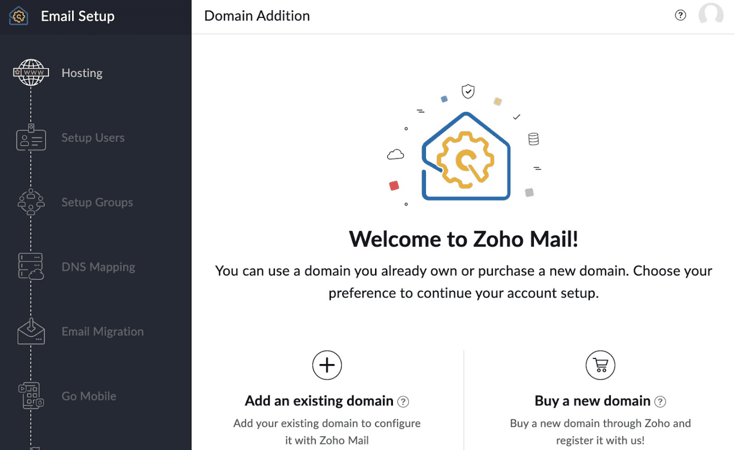
Walk through the DNS configuration and verification steps provided by the host. Usually, this involves adding some records (TXT, MF, and others) to the DNS area of your web hosting or domain hosting dashboard.
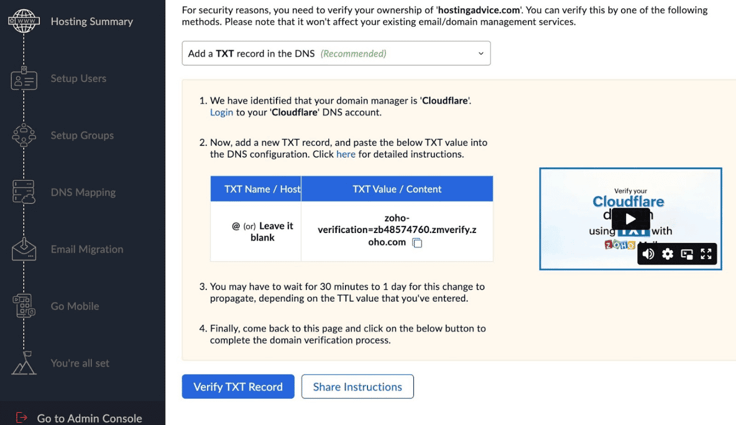
Keep in mind that this process looks different for every email hosting provider.
2. Creating email accounts and aliases
The next step is to create email addresses for everyone who needs one in your organization. This uses your custom domain name for each email address, like admin@example.com.
To add a new email address, go to the section of your dashboard dedicated to users. Fastmail, for instance, has a Users & Sharing link under Settings, which lets you create a new user.
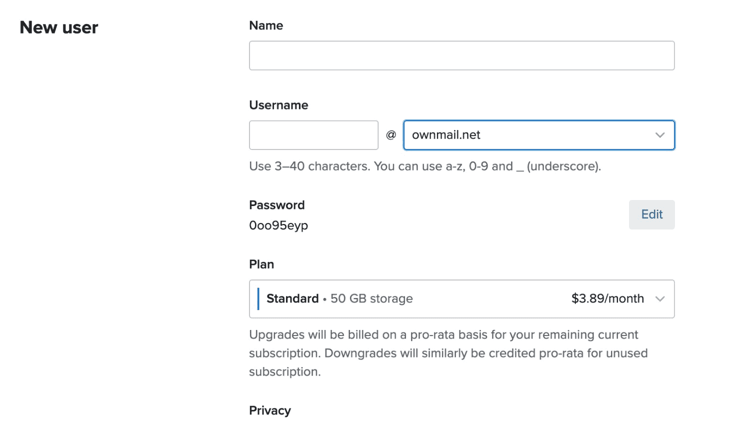
You might also want to add an alias that sends to your main inbox. In Fastmail, there’s a section called My Email Addresses under Settings. This provides buttons to either create an alias or add an address you already own.
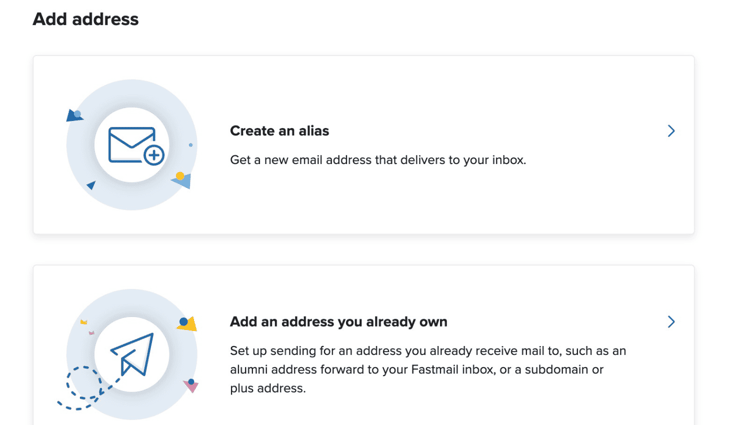
As always, your experience will vary depending on the email hosting provider.
Configuring Email Clients and Devices
Next, you’ll want to connect all your devices for sending and receiving emails, including phones, tablets, and computers.
1. Setting up email clients (e.g., Outlook, Thunderbird, Mail)
An email client serves as the portal for receiving, sending, and organizing emails on your desktop computer.
Choose an option like Outlook, Thunderbird, or Apple Mail. Once installed, open the client to add an email account. Most clients have buttons to connect to popular email services, or you can log in with your email hosting credentials.
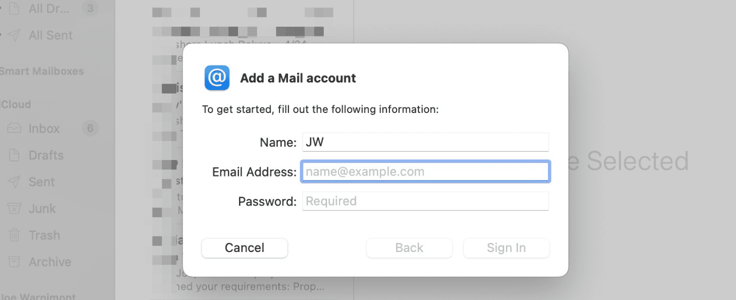
If that doesn’t work, the client should prompt you to log in with more advanced details like IMAP credentials and incoming and outgoing mail servers.
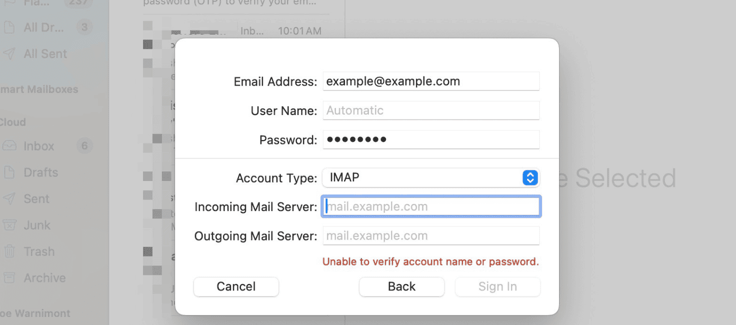
You can find this information from your email hosting provider.
2. Configuring mobile devices for email access
Getting access to your email accounts on a mobile device works similarly to installing a desktop email client. The main difference is that you install an email app through your device’s app store instead of on your computer. Many email hosts have branded apps for Android and Apple phones. There are also third-party email apps for connecting your credentials from any email host.
Best Practices for Managing Email Hosting
While using your email hosting, it’s best to set up automated processes to protect your past messages. You should also consider continually monitoring your email hosting for performance and security threats.
Monitoring Email Usage and Performance
Email hosts provide metrics to see how your email quota is being used. Each email hosting plan comes with a storage limit, meaning you must stay below that or upgrade. Everything from the emails themselves to the downloaded attachments takes up space. It’s recommended that you monitor email usage and performance metrics to ensure you never encounter issues with full inboxes or limited sending capabilities.
Implementing Backup and Disaster Recovery Solutions
Should a disaster occur, it’s essential to have a tool in place for recovering lost data. The best email hosts offer regular, automated backups of your emails, contacts, and other databases. This way, if a hack occurs, you have a way to recover a backup in one click.
Security Vulnerabilities to Consider
As with all technology, email hosting has some risks. Understand the potential security vulnerabilities below to prepare yourself and prevent issues in the future.
Protecting Against Email Threats
Email threats vary in severity; some are simply an inconvenience, while others could take down an entire network. The tools below help you combat the most common threats:
1. Spam filtering and antivirus protection: Spam filtering uses monitoring technology to remove malicious emails. Spam is not only an inconvenience, but it also uses up storage and often contains malicious content. That’s why it’s good to filter spam out. Antivirus protection is similar; a good email host helps identify when an email contains a virus.
2. Advanced threat detection and email encryption: Advanced threat detection monitors for sophisticated cyber threats. It mitigates attacks made through ransomware, phishing, and malware. Similar to spam filtering, advanced threat detection deletes bad emails or puts them in quarantine. Email encryption is also a necessity. It codifies messages, so if someone hacks your email, they have no way of reading the content.
With these tools in place, you should rarely know when a threat arises. But when one becomes apparent, the system warns you.
User Authentication and Access Controls
Besides spam and virus-based threats — attacks from afar — you also have to worry about nearby security threats, like if a disgruntled former employee attempts to misuse your email system. Here are some ways to prevent such issues:
1. Implementing strong password policies: Everyone using your email infrastructure should use strong passwords to prevent brute-force attacks. Create a policy that requires strong passwords. Request that everyone use a password manager to generate these passwords and save them for later use.
2. Enforcing multi-factor authentication (MFA): Multi-factor authentication requires that the user confirm their identity with a second (sometimes third) form of login procedure. This often asks the user to type in their password first. Then, they receive an email, text, phone call, or a code sent to an MFA app. After typing in the code, they can log into their email.
It’s human nature to create weak, memorable passwords. Solve this problem by eliminating the need for workers to remember passwords (with a password manager). On top of that, everyone should use an MFA tool before signing into their email account.
Compliance and Regulatory Requirements
Depending on your location and industry, you may have to abide by certain privacy and technological regulations. Look at the common ones below to ensure your email host complies:
1. Ensuring compliance with data protection laws (e.g., GDPR, HIPAA): Data protection laws like GDPR (for the European Union) and HIPAA (for the U.S.) help keep customer data in the hands of the users. HIPAA, for example, is a law that requires email service providers to implement measures to protect healthcare data inside emails. GDPR requires email hosts to protect their customers’ personal data, often by deleting data once it has served its purpose.
2. Auditing and reporting features for compliance purposes: Seek out email hosts with features like audit logs, activity reports, and compliance reports. These not only let you check in on your email usage, but they also reveal information about the host’s compliance with regulations. For instance, a compliance report might share who has access to the data in your emails. You can also use elements like audit logs and activity reports to research who has accessed your email system.
Enhancing Collaboration with Email Hosting
One main benefit of premium email hosting is its strong collaboration potential. Companies can connect workers through things like calendars, documents, storage tools, and more.
Shared Calendars and Scheduling
With an integrated calendar, businesses can connect not only through email but also through scheduling. This allows workers to manage appointments, schedule meetings, and integrate with productivity suites like Google Workspace and Microsoft 365. For instance, you could add a Google Doc to your calendar so everyone in the organization can see it.
Collaboration Tools and Features
Collaboration tools often come standard with email hosting plans. They include features for creating and sharing documents with others in the organization. You may also gain access to version control features to switch back to a previous version or check what someone has changed in the past. The best email hosts also provide team chat features or messaging integrations for workers to send instant messages.
Future Trends and Innovations to Expect
Email seems like an old, reliable technology, but email hosts continue to introduce new features and security measures that build upon the foundation of email hosting. Here’s what to expect in the future:
Artificial Intelligence (AI) and Machine Learning
With the surge in artificial intelligence and machine learning, plan to see smart filtering and email prioritization implemented in your email inbox. There’s also great potential for automated email management and predictive analytics, something that’s sure to help with productivity and streamline the way we manage our emails.
Integration With Emerging Technologies
Many email hosts already integrate with outside tools. But there’s more to expect with emerging technologies like voice-controlled email assistants that complete tasks — like deleting, writing, and sending emails — with voice commands. Blockchain-based email authentication also shows promise. This would allow the encryption and decentralization of email transactions, improving data security for users.
Harnessing the Potential of Email Hosting
With premium email hosting, your business gains enhanced security, collaboration tools, and the ability to strengthen its brand with custom email domains. It connects the people inside your business, grants an immediate link to the outside world, and blocks threats.
As businesses continue to seek more advanced ways to connect, email remains at the forefront of communication. With improvements to collaboration tools, productivity features, and threat detection, email hosting is poised to continue serving as the world’s primary form of digital communication.







